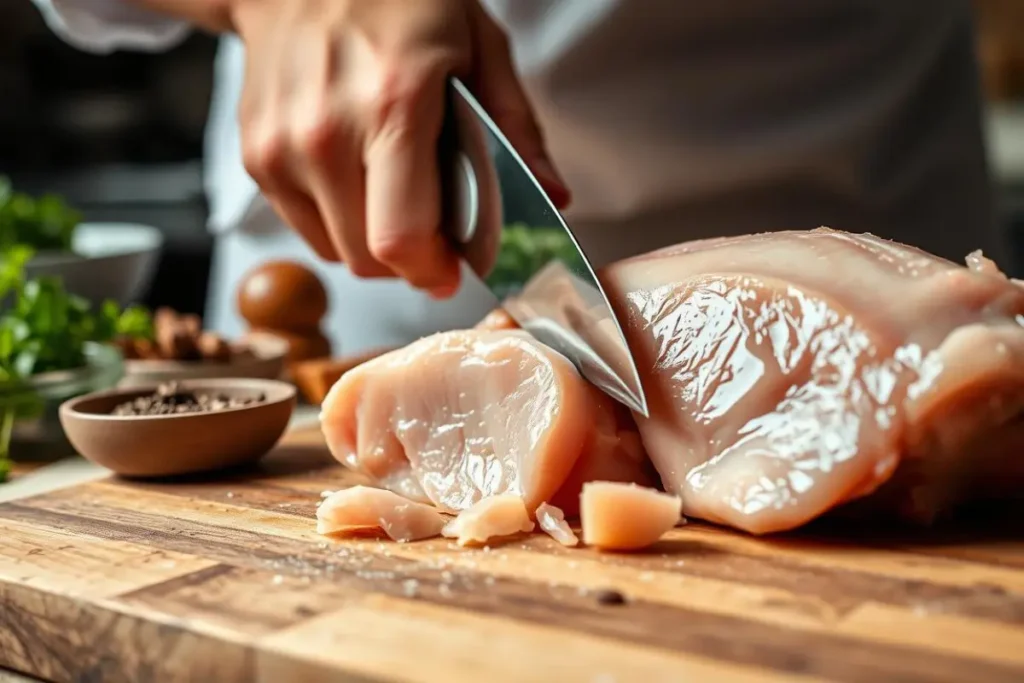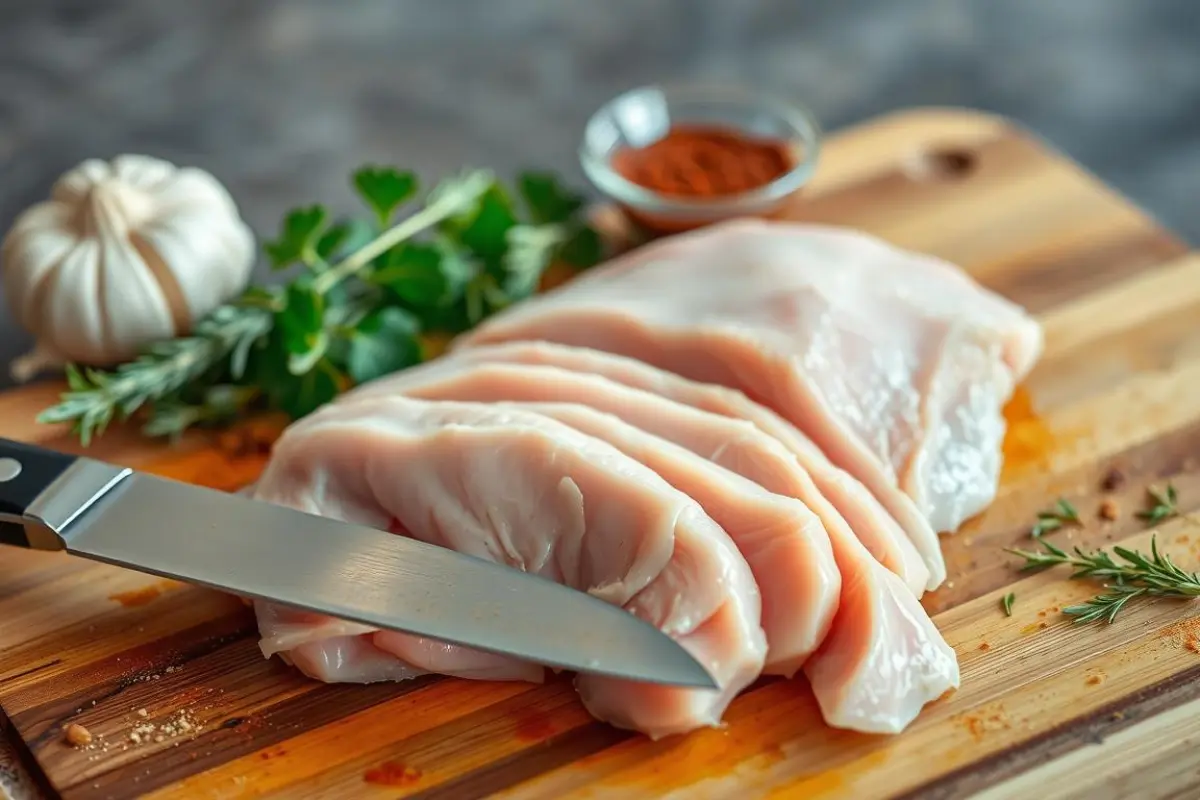How Do They Make Sliced Chicken Breast? This question leads us to a detailed process that starts with carefully choosing raw materials and ends with precise packaging and distribution. Understanding how the food industry handles the slicing of chicken breast can help us make more informed choices as consumers, and appreciate the journey of our food.
Exploring the commercial process of slicing chicken breast is interesting. It shows us the details of food manufacturing. This guide will go through each step of the chicken breast slicing process. We’ll look at quality control and the differences between commercial and manual slicing.
By observing how companies slice chicken breast, we gain more insight into the food industry. This guide is for anyone curious about the chicken breast slicing process. It covers commercial production methods and quality control measures.
Understanding Commercial Sliced Chicken Breast Production
Commercial sliced chicken breast production is a complex process. It involves several key components. To understand this, we need to look at the types of chicken breast products, industry standards, and the equipment used.
The question of are chicken breast slices processed can be answered by examining the production stages. Pre-sliced chicken breast is a big part of the industry. Industrial chicken breast slicing methods have improved to meet demand for convenient and safe chicken.
Advanced equipment and technology help manufacturers produce high-quality sliced chicken. This meets strict industry standards.
Several factors influence commercial sliced chicken breast production. These include:
- Types of chicken breast products, such as boneless, skinless breasts, and organic or free-range options
- Industry standards and regulations, such as those set by the USDA, that ensure products are safe for consumption
- Key production equipment, including slicers, marination machines, and packaging machinery
The pre-sliced chicken breast production process aims to provide a convenient and safe product. By understanding the stages involved, we can see the complexity and scale of the industry.

The production of sliced chicken breast is a detailed process. It requires attention to quality and safety. By looking at the factors that influence production, we can understand the industry better.
| Product Type | Industry Standard | Production Equipment |
|---|---|---|
| Boneless, Skinless Breasts | USDA | Slicers, Marination Machines |
| Organic or Free-Range Options | USDA Organic | Packaging Machinery |
Raw Material Selection and Preparation
The quality of sliced chicken breast depends a lot on the raw materials. To make great chicken breast slices, it’s key to pick chicken breasts with the right size, lean meat, and no defects. Knowing how do you cut chicken breast into slices is important. It affects the final product’s texture and look.
In the chicken breast slicing process, getting ready involves cleaning, trimming, and maybe marinating the chicken. This makes the chicken taste better and feel softer. The quality of chicken breasts comes from how farmers raise them. The diet, breeding methods, and living environment of chickens significantly impact their quality. By choosing the best chicken breasts and preparing them right, makers can make a top-notch product that people love.
Some important things to think about when picking and getting ready chicken include:
- Size and uniformity of chicken breasts
- Lean meat content and fat distribution
- Absence of defects, such as bruising or tearing
- Marination and seasoning to enhance flavor and texture

By focusing on picking and preparing the right chicken, makers can make sliced chicken breast that’s not just safe but also tasty and looks good. This careful attention is what makes high-quality sliced chicken breast. It’s what makes the best makers stand out.
How Do They Make Sliced Chicken Breast: The Industrial Process
Making sliced chicken breast involves many steps. To understand the process, we examine the operation of a commercial chicken slicer. Initially, they trim excess fat and connective tissue from the chicken breasts.
This step is key to get the chicken ready for the next steps. Next, they marinate and season the chicken to enhance its flavor. The methods used for marinating and seasoning can change based on the taste and texture wanted.
Key Steps in Sliced Chicken Breast Manufacturing
- Cooking and cooling are important to make the product safe and ready for slicing.
- They utilize automated slicing technology to ensure uniform thickness of the chicken breasts.
- They perform quality checks to ensure the sliced chicken meets required standards.
The process of making sliced chicken breast aims for consistency and quality. Understanding the production process allows us to appreciate the technology and effort involved in creating our favorite foods. The efficiency of the commercial chicken slicer operation is key to meeting demand.

Quality Control Measures in Production
Ensuring the quality and safety of deli chicken breast is key. Manufacturers use many quality control steps. These include regular checks on the production line and tests for harmful bacteria. Knowing how do they make deli chicken breast shows the value of these steps in keeping things clean and safe.
Some important quality control steps are:
- Regular cleaning and sanitizing of equipment and facilities
- Testing for pathogens, such as Salmonella and E. coli
- Monitoring temperature and humidity levels to prevent bacterial growth
- Implementing industrial chicken breast slicing methods that minimize the risk of contamination
These steps help make sure deli chicken breast is safe and meets customer needs. Quality control also covers packaging and storage. This keeps the product fresh and safe for the consumer.
In producing deli chicken breast, they continuously monitor and improve quality control measures. By focusing on quality, manufacturers gain customer trust. This is vital for how do they make deli chicken breast, as people want to know their food is handled well.
Packaging and Distribution Methods
In the pre-sliced chicken breast production process, packaging and distribution are key. Following slicing, they vacuum-seal the chicken to preserve its freshness. This step is vital in sliced chicken breast manufacturing to keep the product safe and fresh.
The commercial chicken slicer operation includes slicing, packaging, and distribution. It’s important to store the sliced chicken in controlled temperatures and humidity. This ensures the product stays fresh and safe from the factory to the stores.
Vacuum Sealing Technology
Vacuum sealing is a common method in food production, like in pre-sliced chicken breast production. It removes air to stop bacteria and other harmful organisms from growing. The advantages of vacuum sealing are:
- Extended shelf life
- Reduced risk of contamination
- Improved product quality
Storage Requirements
Proper storage is critical in sliced chicken breast manufacturing. The requirements include:
- Controlled temperatures between 32°F and 40°F
- Humidity levels below 60%
- Clean and sanitary storage facilities
By following these guidelines, manufacturers can ensure their pre-sliced chicken breast production is of the highest quality and safety.
Commercial vs. Manual Slicing Techniques
There are two main ways to slice chicken breast: commercial and manual. Commercial slicing uses big machines to make uniform slices. This method is common in large-scale chicken breast slicing.
Professional kitchens and home cooks often use manual slicing techniques. Professional kitchens use high-quality slicers for consistent results. Home cooks can use sharp knives and slightly frozen chicken for cleaner cuts.
Professional Kitchen Methods
Professional kitchens use special equipment for slicing chicken breast. They have commercial-grade slicers that handle lots of meat easily. They also use specific techniques for the best slices.
Home Preparation Tips
For home cooks, using a sharp knife is key to avoid tearing the meat. Slicing when the chicken is slightly frozen helps too. Also, a stable cutting board is important for safety and smooth slicing.
You May Also Like:
- How is Chicken Breast Deli Meat Made? A Complete Guide
- Is Chicken Breast Lunch Meat Healthy? Discover 8 Hidden Benefits
- How to Eat Chicken Breast for Lunch: 7 Delicious Options
Equipment Comparison
Comparing commercial and manual slicing equipment shows their differences. Here’s a table to highlight these differences:
| Equipment Type | Advantages | Limitations |
|---|---|---|
| Commercial Slicers | High-volume capacity, uniform slices | Expensive, requires regular maintenance |
| Manual Slicers | Affordable, easy to use | Limited capacity, requires more labor |
Conclusion: The Future of Sliced Chicken Breast Production
The demand for easy and flexible protein options is rising. This trend will likely shape the future of sliced chicken breast production. The food industry’s emphasis on sustainability and customization could reshape the production and sale of sliced chicken breast.
New technologies in commercial chicken slicer operation could make production faster, waste less, and offer more choices. Also, looking into better packaging and making sliced chicken breast manufacturing smoother might make things greener and cheaper.
Sliced chicken breast will keep being popular because it’s easy to use and versatile. Understanding current production methods and future trends enables businesses to maintain a competitive edge. They can offer top-notch, creative sliced chicken breast to meet market needs.
Frequently Asked Questions
What is the process for making sliced chicken breast?
Making sliced chicken breast involves several steps. First, you select the chicken based on size and quality. Then, you clean and trim it. Next, you marinate it to add flavor.
After cooking and cooling, the chicken is sliced. This is done using special equipment to get even slices.
Are chicken breast slices processed?
Indeed, sliced chicken breast falls under the category of processed food. The process includes trimming, marinating, cooking, and slicing. This makes the product consistent and flavorful.
How do they cut chicken breast into slices commercially?
Commercially, chicken breasts are sliced using automated technology. Specialized equipment, like commercial slicers, is used. These machines cut the chicken into even slices.
The cooked and cooled chicken is fed into the slicer. Sharp blades then cut it to the desired thickness.
How is sliced deli meat made?
Making sliced deli meat, like chicken breast, follows a similar process. They meticulously select and prepare high-quality raw materials. They add seasonings and flavorings before cooking and cooling the chicken.
Specialized equipment facilitates the slicing of the meat. They package and distribute the slices to ensure freshness and safety.
What is the chicken breast slicing process in commercial production?
The commercial chicken breast slicing process includes several steps. First, excess fat and tissue are removed. Then, the chicken is marinated and seasoned.
After cooking and cooling, the chicken is sliced. Specialized equipment is used to cut it into uniform slices.
How do they make deli chicken breast?
Making deli chicken breast is similar to commercial production. High-quality chicken breasts are selected and prepared. They are cleaned, trimmed, and marinated.
Then, the chicken is cooked and cooled. Specialized equipment is used to slice it. The slices are packaged and distributed to ensure freshness and safety.
What equipment is used for commercial chicken breast slicing?
Commercial chicken breast slicing uses specialized equipment. Slicers are automated machines with sharp blades. They cut the chicken into uniform slices.
Marination machines help distribute seasonings evenly. Packaging machinery seals the slices to keep them fresh.

